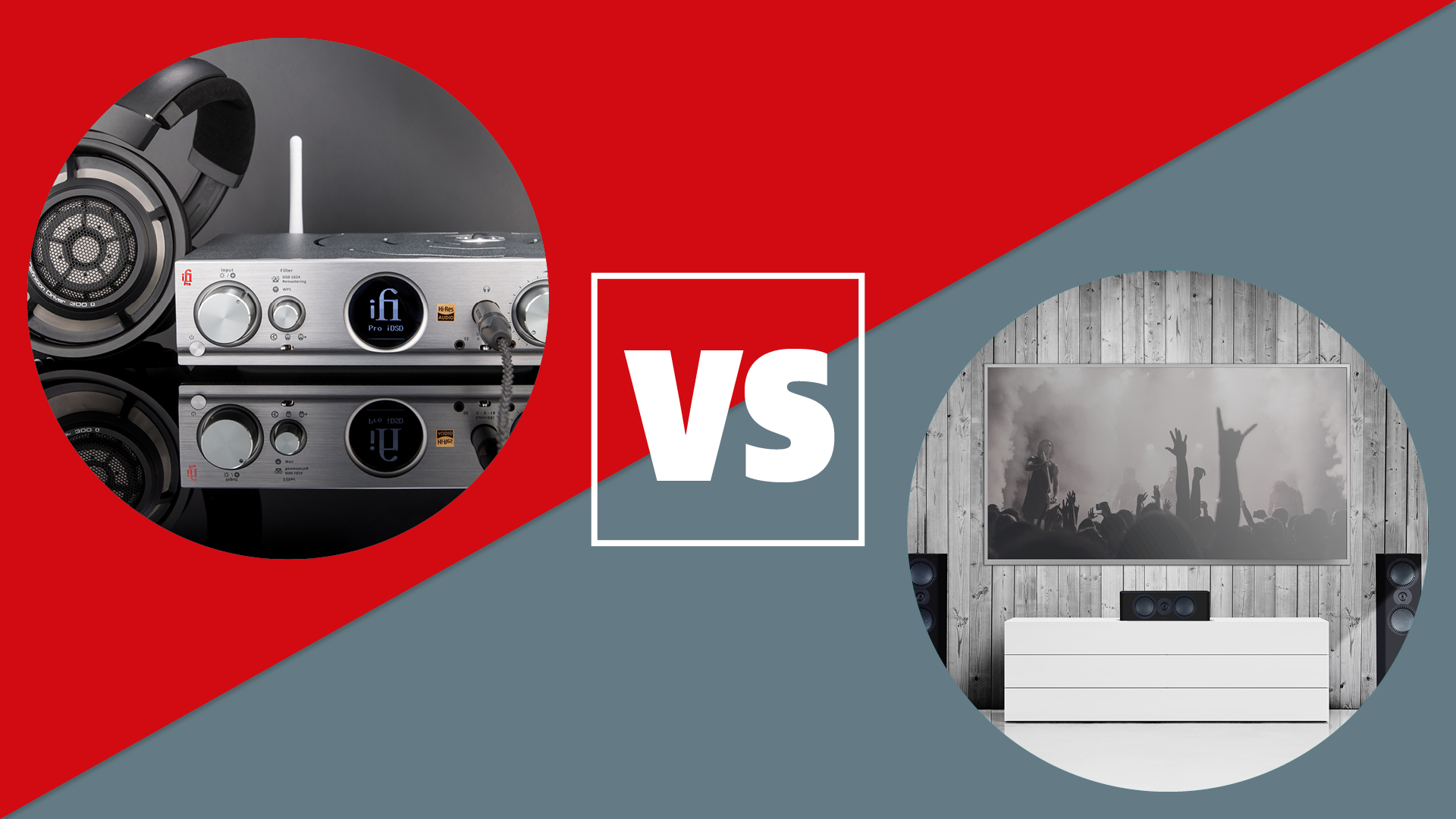Head-fi is better than hi-fi – but not nearly as fun
When it comes to experimentation and the physical experience, there's an outright winner

I was spoilt, it’s true. For the best part of a decade, I spent a great deal (if not the majority) of my 9-5 in front of more hi-fi components than I’d care to hazard a guess at, not to mention more time with What Hi-Fi?’s reference system than with my own mother.
A step away from that specific role has, for various reasons, encouraged me to get even better acquainted with the head-fi market. I’m primarily talking wired headphones plugged into a DAC/headphone amplifier connected to a laptop or music player here. Desktop gear.
In one way, it’s confirmed what I had already experienced: generally speaking, head-fi trumps hi-fi in terms of sound per pound value. But one new realisation has been this: it’s not nearly as fun to play around with.
Head-fi sound > hi-fi sound
If you have a certain amount to spend, and are flexible enough to simply want whatever audio kit will give you the most insight into your favourite song, you'll probably want a pair of headphones and a headphone amp/DAC.
Until you get to crazy system money, the best headphones and amp/DAC pairing you can afford will sound better than the best hi-fi system costing the same amount of money – more immediate and more detailed, even if you’re sacrificing the more tangible soundstage and bass rumble speakers present.
Partnered with similar-level electronics, how much would speakers offering the same performance quality as the £250 / $295 / AU$419 Grado SR325x cost? Probably in the region of £2k / $3k / AU$4k. How about the £4799 / $5000 / AU$7499 Yamaha YH-5000SE? Perhaps five times that. And this is on the basis that, in both cases, the speakers are driven by very good price-suitable amps (costing far more than suitable headphone amps for those cans) and performing in a really good room.
Think about it: with personal listening you are invariably paying less for physical materials, the drivers are right by your ears, and you can more or less take the room you’re listening in out of the equation.
The latest hi-fi, home cinema and tech news, reviews, buying advice and deals, direct to your inbox.
That’s the first part of my headline swiftly covered. And now for the second part: while headphones and headphone amp/DAC set-ups may have advantages over hi-fi systems that go beyond sound quality value even (space, neighbour peace etc) they are, in my opinion, no substitute for the fun you get from a full speaker-fronted separates system.
No room, little tweakery
Most of the fun (and indeed frustration) we can get from setting up hi-fi systems is trying different placements, making cosmetic room adjustments, and seeing what differences (if any) accessories like isolators can make. For optimal-sounding hi-fi, you usually have to work for it. For head-fi, however, the set-up is comparatively tame – more Monday night than Friday night levels of entertainment – and straightforward.
Yes, you should put any and all electronics on a sturdy tabletop, but once you’ve done that, cabled it up and plugged in your intrinsically fuss-free headphones, that’s about it. You’re ready to go in a few minutes. Because the room is primarily taken out of the equation (advantageous to performance, yes), there’s nothing to try toeing in or inching closer to a wall, no direct reason to de-cushion or cushion-up your sofas, no spikes or stands or room correction software or additional subwoofer to try. Your source for a desktop head-fi system will likely be the phone or laptop you already overuse every day, too. And of course, personal listening isn’t very social either! Just as you might find listening to music more fun alongside another in a communal environment, testing within our reviews team is definitely more fun when we can all listen together.
Rarely are there many integrated features to experiment with beyond crossfeed modes and the odd EQ boost processing, either – though higher-end desktop electronics tend to go harder on EQs and digital filters. What Hi-Fi?’s technical editor recently noted how refreshing he found testing the TAD’s DA1000TX DAC due to its lack of tweakability, as he rarely finds various DAC sound options useful. “I wish the engineers would just finish the job and settle on the sound they like the best,” he said. I too find myself rarely faced with a processing option I prefer left on, though I do admire engineers’ efforts to cater for different tastes this way.
The physical experience
Then there’s the physicality of the hi-fi sound experience; the way it can literally impress on you. The most obvious example perhaps is the way you can feel deep bass through your body – especially sub-60Hz, and perhaps via the floor, even. That is notably less tangible through headphones.
As stereo music is recorded to be delivered in front of the listener, it’s little surprise that imaging through a pair of speakers’ soundstage is comparatively more precise and dimensional. Unless we’re talking binaural recordings through headphones, that is! That speaker soundstages are bigger naturally helps too.
Less appreciably tactile but still contributing to the physicality of a hi-fi system’s output is the fact that you have air constantly pumping out from the speakers, moving dynamically around and interacting with you.
And while this might be in contrast to ‘fun’, music through a speaker system is also inherently less demanding and can therefore be more relaxing. Because a) you aren’t required to wear anything, and b) the drivers are at a greater distance.
Fewer upgrade paths
In many head-fi scenarios, there are fewer parts to the chain and therefore fewer ways to upgrade it. You might be able to swap out your headphone cable for another or upgrade a USB cable or interconnect. Some headphones might offer two types of earpads, giving you a chance to hear what in my experience are very subtle differences. Other than that, you’re upgrading the headphone DAC/amplifier or headphones themselves to reach the next rung up on the performance ladder.
Hi-fi, on the other hand, has an endless accessory category (some accessories being more tenuous than others, perhaps!) and a greater opportunity to try things without parting with much money, not to mention that hi-fi components are more likely to have upgrade paths such as power supplies and expansion modules developed for them.
Don’t get me wrong, I adore head-fi for its intimacy and as an accessible gateway to high sound quality. I like how I can take easily take it from my work office to my living room for a more leisurely, comfortable listening session. I’d choose to save my headphone set-up from a burning building over my hi-fi one – and not just because it’d be easier to bundle out of the door! But with its more involved and adjustable nature, plus the fact that you can more comfortably listen loudly – and socially – when you want to, hi-fi is just more fun, isn’t it?
MORE:
How to build the perfect hi-fi system
The most important component in your hi-fi system isn’t what you think it is
Enjoy your favourite music on the go with this killer portable hi-fi system

Becky is a hi-fi, AV and technology journalist, formerly the Managing Editor at What Hi-Fi? and Editor of Australian Hi-Fi and Audio Esoterica magazines. With over twelve years of journalism experience in the hi-fi industry, she has reviewed all manner of audio gear, from budget amplifiers to high-end speakers, and particularly specialises in headphones and head-fi devices.
In her spare time, Becky can often be found running, watching Liverpool FC and horror movies, and hunting for gluten-free cake.
